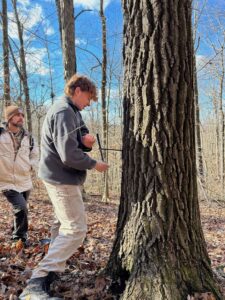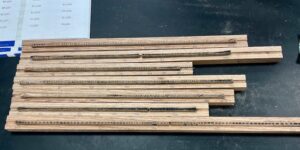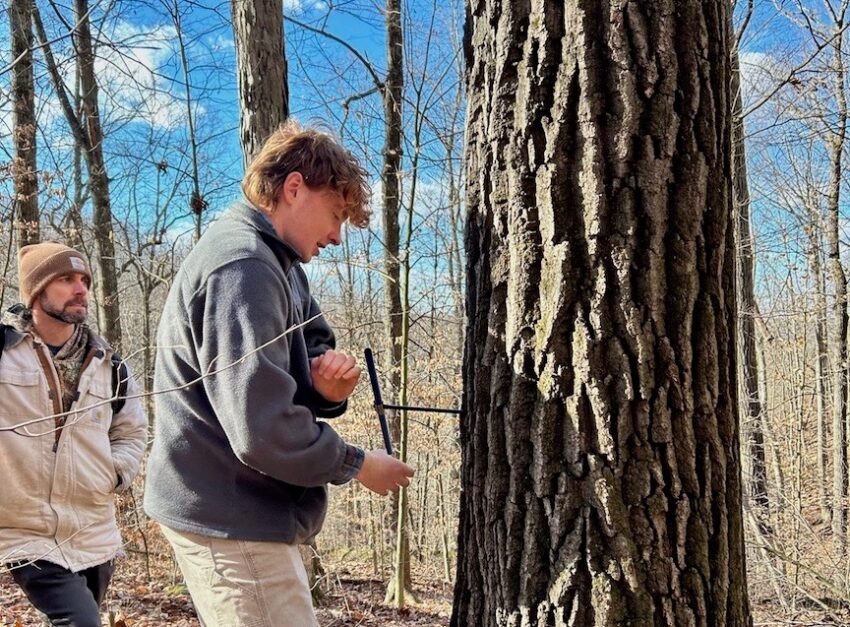Armed with a two-foot-long hollow drill bit, sturdy boots, and equal parts curiosity and patience, Sam Gutekanst headed off-trail on a cold January afternoon to delve into the secrets of some of the oldest trees in the Lindy Roosenburg Preserve, a member of the national Old-Growth Forest Network
 Sam, Athens Conservancy board member and Ohio University undergraduate student, along with a few of his Conservancy colleagues, used dendrochronology to scientifically date the trees by their tree rings. The method can pinpoint the age of the tree and provide clues about forest health and climate.
Sam, Athens Conservancy board member and Ohio University undergraduate student, along with a few of his Conservancy colleagues, used dendrochronology to scientifically date the trees by their tree rings. The method can pinpoint the age of the tree and provide clues about forest health and climate.
The painstaking process involves hand-drilling a long drill bit halfway through the tree to its center, and extracting a pencil-thin core without causing any harm to the tree itself. These cores show each ring encapsulated within the tree’s trunk, with the number of rings corresponding to the years the tree has been growing.
“The size of a ring tells you a lot about that year,” explained Sam, who is majoring in environmental and plant biology in OU’s Honors Tutorial College. “If it was a really good year, the ring will be larger because the tree put on a lot of growth that year. But if the ring is small, it wasn’t such a good year for growth. Weather, temperature, and rainfall are big determiners.” The method also can give clues about years the forest had been logged.
Keep reading; a few videos follow the story!
The group took core samples from seven trees in the 71-acre preserve near Chauncey, using coring equipment graciously lent to the group by Dr. Rebecca Snell at OU, in whose lab Sam recently completed a dendrochronology tutorial. Focusing on oak trees in the forested preserve, they cored a white oak, two black oaks, and four chestnut oaks.
“The oldest tree was a chestnut oak that was over 140 years old, and surprisingly, it was one of the smaller trees we cored,” said Sam. “The size of a tree doesn’t always translate to its age. Older trees may have slower growth because they’ve been growing in the shade (of the forest) for a hundred years.”
Sam said most of the trees’ rings were pretty consistent in size, with varied ring sizes revealing forest clues. “You can tell when the surrounding forest was logged by a tree’s rings,” he explained. “The rings will get a lot bigger right after logging because there’s more light hitting the tree, and it has more growth.”

Phil Cantino, long-time Conservancy board member and retired plant biology professor, added, “When we applied for membership in Old-Growth Forest Network, I estimated that the forest in that part of the preserve is at least 120 years old, based on 1939 air photos and current forest cover. It is gratifying to learn that this estimate was correct. Three of the seven trees Sam cored are between 128 and 140 years old. The tree ring sequences show no evidence of widespread logging in that part of the preserve, but there appears to have been selective logging around 1915 and perhaps also in the 1880s.”
More information on the tree ring sequences and what we can infer about logging history
in this part of the preserve can be found here.
A topographic map showing the locations of the cored trees can be found here.
The coring process itself takes a little patience and a lot of arm muscle. “The black oak we cored took three people working for a half hour to core it. We had to remove the drill bit almost immediately or the sap in the tree would start to seal around it,” Sam said.
Once the thin, cylindrical core is removed, it’s carefully taken to a lab or wood shop for study. “The core is attached to piece of wood with a groove in it, where it can sit there real nice,” he said. “You sand it down so you can see the rings better, and polish it with very fine sandpaper. Then you can look at it with a microscope and count the rings slowly and carefully.”
Why go to all that trouble? “Coring a tree is a lot of work, and it’s a lot of work after it’s cored, too,” Sam admits. “But it’s really useful if we want to find out how old a particular tree is, or how old a forest is.
“Plus, it’s just very cool to be able to tell all of these things from a piece of wood,” he said. “It’s very cool technology.”
Ages of the Trees Cored
Minimum age is stated as of 2024, though the most recent ring was formed in 2023. The actual age would have been 5-10 years older because the tree had to grow to the height at which the core was taken. Organized from largest (diameter at breast height) to smallest
DBH species ID code earliest growth ring Minimum age (in 2024)
107 cm black oak BO2 1922 102 years
83.5 cm black oak BO1 1927 97 years
68.1 cm white oak WO1 1896 128 years
59.3 cm chestnut oak CO3 1912 112 years
59.3 cm chestnut oak CO4 1920 104 years
58.2 cm chestnut oak CO2 1888 136 years
43.5 cm chestnut oak CO1 1886* 140+ years*
* In CO1, the core missed the center by a few years, so the tree is older than 1886. An estimate of at least 140 years is reasonable.
Below are two short videos of Sam Gutekanst and the tree-coring expedition!

